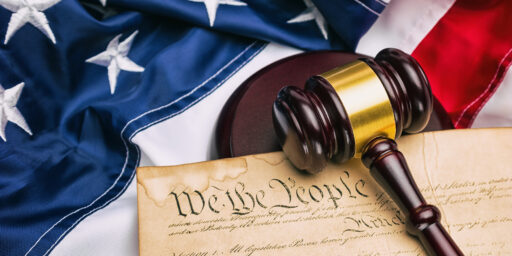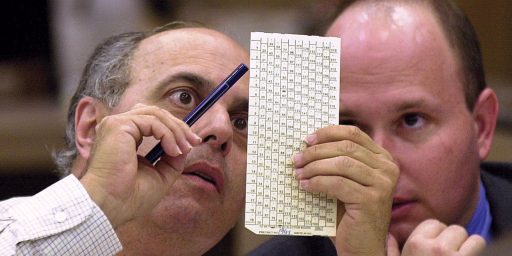Election Headed for the Courts
Jeffrey Rosen thinks the odds are high that we’ll see a rematch of Bush v. Gore.
Throughout U.S. history, of course, close elections have been followed by litigation. But Bush v. Gore has exponentially increased the legalization of politics. “There’s no question that Bush v. Gore has made courts more open and sensitive generally to claims about voting breakdown,” says Robert F. Bauer, who is coordinating postelection legal challenges as national counsel for the Democratic National Committee. The decision has been cited in more than 30 lower court opinions during the past four years and invoked in challenges to nearly every close election.
Moreover, Bush v. Gore has made candidates far more aggressive in preparing for litigation. To contest the Florida recount in 2000, Democrats and Republicans assembled legal teams on the fly. By contrast, in anticipation of a protracted legal battle this November, both the Bush and Kerry campaigns have made elaborate preparations. The Bush campaign plans to have party lawyers in every state, including more than 30,000 precincts. And the Kerry campaign has set up an unprecedented national legal network involving more than 10,000 volunteer attorneys who are already preparing litigation over voting machines, voter registration rules, and questions over which ballots are counted or disqualified. “Every counting rule in every one of the key states is already in a binder,” says Bauer. “All of the background work has already been done so we don’t have the scramble that inevitably occurred in Florida.”
What’s striking about the legal strategies of the Bush and Kerry swat teams is how much they plan to rely on Bush v. Gore, which turns out to be an inexhaustible font of rhetoric and novel lawsuits. The first set of possible challenges involves claims similar to those at the heart of the Florida mess in 2000–arguing that each individual voter has the right to have his or her vote counted in precisely the same way. When the Court invented this right in Bush v. Gore, it was hard to fathom what the justices had in mind, since the claim that each state had to have uniform voting standards was impossible to reconcile with local control of the electoral process, where there is enormous variation among voting technology, hours of poll access, and rules about the disqualification of ballots.
The ruling applied on to the counting of ballots within a single state and specifically to a court-ordered recount that was going to be selectively applied in violation of state law. The Court never argued that states had to all use the same voting machines. And, of course, Bush v. Gore was the end of the process, not the beginning. The election had been politicized by the side that lost the election and which found a sympathetic state court willing to overrride state law, forcing the Supreme Court to get involved. It’s therefore rather disengenous to claim that Bush v. Gore was the reason for the trend that followed.
Indeed, as Rosen himself notes later in the piece, this “new” trend has been with us for forty-odd years.
Far from being an aberration, Bush v. Gore is the epitome of what Richard L. Hasen of Loyola Law School has called the third phase of electoral litigation. The first phase, in the 1960s, announced that “one man, one vote” was a constitutional requirement. Emphasizing the right to an equally weighted vote, the Court forced the states to create electoral districts with nearly equal numbers of voters. The second phase, which began in the 1970s, focused on the right to an equally meaningful vote. Declaring that certain electoral arrangements–such as at-large elections–might make it harder for minorities to elect representatives of their choice, the Court came close to declaring a constitutional right to proportional representation. And, when the Court stepped back from this precipice, Congress in 1982 created a federal right for minorities to elect representatives of their choice. This led to an unlikely alliance of GOP operatives and minority rights advocates who supported the creation of minority districts, effectively isolating Democratic voters in the South.
In response, the Court inaugurated in the 1990s the third phase of electoral litigation. In Shaw v. Reno in 1993, it declared that oddly shaped voting districts created for the benefit of minorities might be unconstitutional not because they violated the right to an equally weighted or equally meaningful vote, but because they sent a message to white voters that their concerns might not be taken seriously. The Court had difficulty defining precisely what was wrong with these districts, aside from the fact that they looked funny, and, for a decade, the borders of nearly every minority voting district in the country were considered tentative until Justice Sandra Day O’Connor decided whether their shape was so bizarre as to be unconstitutional. After reigning for a decade as aesthetic adjudicator of every minority district in the nation, O’Connor abruptly switched sides in 2001 and voted to uphold the North Carolina district that she had questioned in Shaw v. Reno eight years earlier.
Indeed, while arguably lamentable, it’s not at all surprising that elections are now being settled by courts, given that political losers have been seeking to obtain through lawsuit what they couldn’t achieve in the legislature since at least the 1950s.
The unfortunate result is that every contested election in the country is now vulnerable to being resolved by O’Connor and her colleagues. And the fact that they attempted in Bush v. Gore to deny the obvious implications of their intrusion into the political process only makes their intervention more reckless. Did they really believe they could create a right to political equality without defining it, in an age when society disagrees so vigorously about what equality requires? Did they imagine for a moment that Democrats and Republicans would meekly tug their forelocks rather than use electoral litigation as a partisan tool? And did they think that courts could presume to recast themselves as election supervisors without calling their own impartiality into question?
Whether or not the presidential election of 2004 is close, Bush v. Gore will continue to distort and confuse U.S. elections more aggressively with each passing year. The disastrous consequences of the Court’s decision to legalize U.S. politics have only vindicated the fears of Felix Frankfurter, who warned nearly 60 years ago of the dangers of judicial excursions into what he called “the political thicket.” “It is hostile to a democratic system to involve the judiciary in the politics of the people,” Frankfurter wrote. “And it is not less pernicious if such judicial intervention in an essentially political contest be dressed up in the abstract phrases of the law.” Worst of all, having now led us into the political thicket, neither the conservative nor the liberal justices have any way of getting us out.
There’s little doubt Frankfurter was right. But it’s not entirely clear what the alternative is. Given the high stakes involved, the incentive for interested parties to cheat in close elections is strong. Neither side seems to feel constrained by simple decency to play by the a priori rules and the courts are the natural referee. Unfortunately, courts are slow and not nearly as neutral as they would be in an ideal world.





My favorite partisan is Scalia. When five of the USSC judges finally stopped the statewide recount ordered by the Florida Supreme Court Scalia said that they had to act cause if the ballots were counted they could jepordise the legitimacy of Bush’s presidency. Clearly he intended to give the election to Bush all along regardless of the real winner.